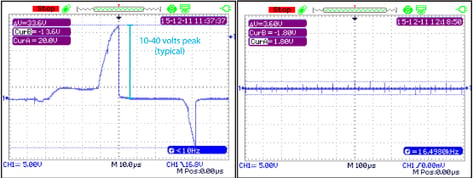Variable frequency drives (VFDs) enable precise speed control and significant energy savings, but they can also cause motor-bearing failure. VFDs take smooth electric power and break it up into pulses. These pulses create a voltage imbalance in the motor that can build up on the shaft. This shaft voltage can discharge through the bearings, causing cumulative damage and premature motor failure.
These destructive discharges can be seen with a digital oscilloscope equipped with a conductive microfiber probe tip, like the AEGIS® Shaft Voltage Tester™. A typical bearing discharge is shown on the left below, where voltage gradually builds up to several volts (~20V here) and then suddenly collapses back to baseline.

One effective way to avoid shaft voltage damage is to equip motors with an AEGIS® Shaft Grounding Ring. These rings' conductive microfibers contact the shaft and safely "bleed off" shaft voltage before it can build up high enough to discharge through the bearings. A shaft voltage reading from the same motor, but with an AEGIS® Ring installed, is shown above on the right. The AEGIS® Ring reduced peak shaft voltage by about 90%.
AEGIS® Rings can easily be installed on in-service motors. And for new motors, several major motor manufacturers produce lines of inverter-duty motors with AEGIS® factory-installed either inside or outside the frame. Also, AEGIS® Rings are long-lived and rarely wear out or need replacement.
For more information on the problem of shaft voltage on VFD motors and best practices for bearing protection in a variety of situations, see the AEGIS® Bearing Protection Handbook. Or feel free to contact us with any further questions.

